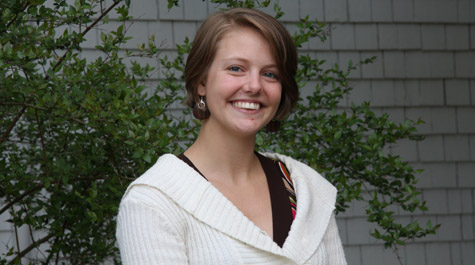'Eco-village' to serve as model of sustainability on campus, beyond
William & Mary's lodge buildings may soon serve as a model for people and businesses looking to create and sustain "green" living spaces.
Members of the College's Committee on Sustainability (COS) discussed turning the buildings into an "eco-village" at the Board of Visitors meeting today. William & Mary President Taylor Reveley will make a formal announcement regarding the project on Earth Day, proclaiming it as an overall "Do One Thing" commitment for the College.
"It's interesting how it all comes together in this one project - the research, the community outreach, and the student life component," said Caroline Cress '10, who presented the project at the meeting. "It's just amazing. Everything I wanted to see happen is finally happening."
According to the proposal, the lodges' seven living spaces and Daily Grind coffee shop would be transformed into a village of sustainable buildings using existing and cutting-edge technologies, construction materials and designs.
Each space would be different. For instance, one might be a solar-powered home and another might use wind power. Student and faculty research will play a part in the creation of the spaces, and the research will continue once the buildings are occupied.
Dennis Taylor, co-chair of the COS, said that the lodges, located behind the Sadler Center, provide an ideal setting for the eco-village.
"It's a really exciting prospect," said Taylor. "These buildings were built in 1947 so there's a little history there. Many people have lived in them over the years. They are very centrally located on campus, and there's a lot that you can do in terms of native plant landscaping and things around them that just sort of puts it all together."
When the buildings are complete, they will be available for any students to live in.
"You wouldn't necessarily have to have an environmental interest because part of the grand experiment is to see how regular people who don't have an interest in this stuff actually function in these kinds of environments," said Taylor.
Additionally, members of the community will have the opportunity to visit the buildings to get ideas for creating their own sustainable living spaces. The Daily Grind - which will remain a coffee shop - will serve as an example of how businesses can become more environmentally friendly.
"One of these could be renovated and equipped in a way in which somebody who had their own house and was interested in doing something more sustainable with their house could actually see what they could do in a normal residence instead of using high technology," said Taylor.
Cress said that making the buildings available for members of the community to see will be an important step toward making sustainability accessible to a larger audience.
"Each house is going to be a model for a different circumstance, so families can come in and see what design is best for them," she said. "It will really be a demonstration of what you can do no matter what your circumstance or starting point."
And while the buildings are being lived in, used and visited by community members, they will continue to provide researchers with opportunities. The diverse use of green technologies, techniques and living conditions will allow researchers to do comparative studies on things such as energy sources, construction materials and renewable landscaping. Additionally, research may also be conducted on the social aspects of living in a sustainable building, tracking "how people live in these buildings, how it changes them, and how they change the building," according to Cress.
"We envision it as a mutually reinforcing relationship between the design of the building and the lifestyle of the resident, since it's not going to be isolated as special-interest housing," she said. "It's going to be open to anyone who wants to live in these houses. So that will be a really interesting research aspect of it, to see if living in a space that's sustainably designed and built affects the way that you live in it, and if the way you live in it in turn affects the building."
The idea for the eco-village has been in development since last fall when COS co-chairs Taylor and Lynda Butler met with Anna Martin, vice president for administration, to discuss the possibility of creating "green" housing. A group was created with students and representatives from Facilities Management to brainstorm about the possibility. From those discussions, the group created a working plan, which they presented to Reveley. They are currently working with University Development to garner funding. The COS has currently designated $10,000 from the student "green fee" fund to go toward the project.
Cress, who has long been involved in the sustainability movement on campus said she is excited to see this project get underway.
"It's a really exciting culminating moment to have a project of this magnitude finally happen. It shows that we are beginning to think bigger and pursue broader sustainability intiatives on campus," she said.
She said she thinks the project will be a great thing for William & Mary—and hopefully just the first of many others to come.
"I think this will really, really infuse a lot of energy into the campus community. Everyone, from students and faculty to staff and the administration , will have something big to rally around and be proud of the College for doing. It's time that the College demonstrates that it's committed to sustainability, and this is the perfect way to do it."

















